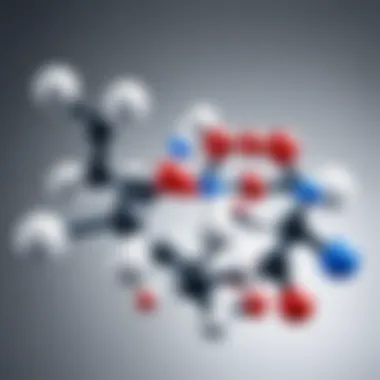Exploring Filoxan: Properties and Diverse Uses


Intro
Filoxan is not just another chemical compound floating around in the vast universe of science; it’s a powerhouse with the potential to reshape industries like agriculture and skincare. Understanding filoxan involves not just a look at what it is, but also how it works, its various roles, and what it means for the future of our health and the environment.
As we navigate through its properties, applications, and the implications of using this compound, it becomes apparent that filoxan may play a significant role in enhancing both plant resilience in agriculture and the effectiveness of skincare products. Its unique attributes have sparked interest across various scientific fields, prompting a deeper examination of its benefits and potential concerns.
This exploration not only aims to clarify what filoxan is but also to shed light on its historical development, biological interactions, and safety considerations. By the end of this article, readers can anticipate a clearer understanding of why filoxan holds a prominent place in contemporary discussions surrounding agriculture and cosmetic science. Let's embark on this journey to unearth the layers of filoxan, from its historical roots to its projected future.
Prelude to Filoxan
Filoxan, a lesser-known yet powerful chemical compound, has garnered attention lately for its role in both agricultural and skincare applications. Understanding the significance of filoxan is essential, especially as industries continue to seek innovative solutions to complex problems. This section sets the stage by examining the various aspects of filoxan, from its fundamental properties to its broader implications.
Definition and Overview
Filoxan is classified as a dihydroxyphenyl compound, notable for its unique properties that make it a candidate for various uses across multiple sectors. Unlike many of its counterparts, filoxan possesses a distinct molecular structure that allows it to interact effectively with both biological systems and non-biological environments. This dual capacity underpins its relevance in practices aimed at improving plant health as well as enhancing personal care formulations.
Chemical Structure
The chemical structure of filoxan reveals critical insights into its functionality. It consists of a dihydroxybenzene core which contributes to its stability and reactivity. The presence of hydroxyl groups grants it hydrophilic characteristics, enabling it to bind with water molecules effectively, which boosts its efficacy in formulations made for plant health and skin care.
Additionally, the arrangement of atoms and the bonding pattern in filoxan allows it to participate in various molecular interactions that facilitate positive outcomes in plants and skin alike. As scientists continue to investigate, more knowledge about the structural nuances of filoxan may open doors for enhanced applications that leverage its chemical advantages.
Historical Context
To fully grasp the implications of filoxan in today’s world, an exploration of its historical trajectory is fundamental. Filoxan was first synthesized in the mid-20th century, a period marked by considerable advancement in agricultural chemistry and cosmetic science. Initially, its use was limited to specific areas, primarily in experimental fields.
The rise in agricultural challenges, such as pest resistance and climate change, saw the reevaluation of older chemical compounds. This shifting focus brought filoxan back into the limelight as researchers began to recognize its versatile potential. As an increasing number of scientific studies emerge, the evolution of filoxan reflects broader trends in environmental sustainability and health consciousness, marking it as a compound worth attention.
Understanding the historical context of filoxan provides valuable insights into its development and eventual integration into modern practices.
In summary, the introduction to filoxan sheds light on its significance across various domains. By understanding its definition, chemical structure, and historical evolution, we can better appreciate its potential and the future research it inspires.
Biological and Chemical Properties
Understanding the biological and chemical properties of filoxan is crucial as it informs its applications across various disciplines, particularly in agriculture and skincare. The core elements of these properties determine how filoxan interacts with biological systems and its overall effectiveness. This section highlights the significant molecular interactions, stability, and solubility of filoxan which collectively contribute to its potential benefits for both plant health and skin care.
Molecular Interactions
Filoxan's effectiveness hinges on its molecular interactions, which dictate how it engages with living organisms at the cellular level. This chemical component is well-noted for its ability to interact with specific proteins and receptors in plants and human skin. For instance, filoxan has a unique affinity for certain plant enzymes, enhancing stress resistance mechanisms, like those against drought or pests.


Moreover, its ability to interact with cell membranes can lead to improved nutrient absorption. It doesn’t merely sit idle; rather, it promotes a more dynamic exchange of essential nutrients, helping plants thrive under challenging conditions. In skincare, filoxan's ability to penetrate the skin barrier and interact with dermal cells is noteworthy. This interaction is fundamental in its role as a hydrating agent.
Stability and Solubility
A chemical’s stability and solubility play a vital role in determining its practical applications. Filoxan exhibits commendable stability, even under various environmental conditions. This stability allows it to be effective over extended periods, making it especially advantageous in agricultural settings where sustained protection against pests and diseases is necessary.
In terms of solubility, filoxan demonstrates a balanced profile - it is soluble in both polar and non-polar solvents, which facilitates its application across different formulations. For farmers, this means it can easily be incorporated into various spray solutions without losing efficacy. In cosmetic formulations, this solubility aids in its seamless incorporation into hydrating creams and serums, enhancing the overall product performance.
Efficacy in Plant Health
Filoxan’s role in plant health cannot be overstated. When employed correctly, it has shown promising results in promoting resilience against a range of environmental stresses. For example, numerous studies have demonstrated that filoxan can contribute to enhanced root development and improved water retention in plants, leading to increased yield.
- Enhanced Disease Resistance: Filoxan stimulates the production of defense-related proteins, offering a robust shield against pathogens.
- Improved Stress Tolerance: Plants treated with filoxan exhibit better adaptability to varying environmental conditions, reducing susceptibility to drought and temperature extremes.
- Increased Nutrient Uptake: Filoxan encourages optimal root function, resulting in better absorption of essential minerals and nutrients necessary for growth.
Ultimately, the biological and chemical properties of filoxan not only underscore its utility but also pave the way for future innovations both in agricultural efficiency and skincare efficacy.
"Understanding the underpinning biological properties is fundamental for harnessing filoxan's full potential in contemporary applications."
This exploration of molecular interactions, stability, and effectiveness sets the stage for practical applications, particularly as we dive deeper into the agricultural and skincare benefits of filoxan.
Applications in Agriculture
The significance of filoxan in agriculture cannot be overstated. As growers face more challenges than ever—be it climate change, pest resistance, or diminishing natural resources—tools that offer versatile solutions become invaluable. Filoxan stands out as a promising candidate, providing various avenues for enhancing agricultural practices. This section will discuss its role in crop protection and the benefits it brings to sustainable farming practices, shedding light on both its effectiveness and its potential drawbacks.
Role in Crop Protection
Filoxan is increasingly being recognized for its role in protecting crops from a myriad of pests and diseases. Unlike traditional pesticides that often rely on harsh chemicals, filoxan operates through more subtle, yet effective means. One of its primary mechanisms involves disrupting the biological processes of harmful insects. By targeting specific molecular interactions, it manages to limit pest populations without creating the widespread ecological disturbances associated with conventional methods.
It’s important to note that filoxan can also benefit beneficial insects and soil health. It does not indiscriminately eliminate all insect life; rather, its selectivity allows essential pollinators to thrive while discouraging harmful species. This selective action is crucial in promoting a balanced ecosystem on farms.
Furthermore, filoxan can contribute to the reduction of pesticide residues in agricultural products, something that consumers and regulators alike are increasingly concerned about. Less reliance on traditional chemical inputs can help maintain the integrity of the market, where organic fruits and vegetables are often prized. Its effectiveness at lower application rates also leads to reduced costs for farmers, promoting both economic and environmental sustainability.
“Utilizing filoxan in crop production reflects a paradigm shift towards more integrated farming strategies.”
Benefits for Sustainable Practices
Filoxan's implications for sustainable agriculture are broad and profound. For starters, its ability to enhance crop resilience is game-changing. When crops are protected from stressors—whether they be pests, diseases, or environmental extremes—they can allocate more energy to growth and production. This resilience translates to higher yields over time, making filoxan an essential player in the push for food security.
Moreover, by adopting filoxan, farmers might find themselves better equipped to comply with strict environmental regulations. The reduced environmental footprint means that growers can produce food with fewer chemicals, aiming towards a circular agricultural system where inputs are minimized, and outputs are maximized.
In addition, filoxan encourages farmers to embrace integrated pest management (IPM) strategies. IPM focuses on using a combination of techniques to control pest populations, incorporating biological, cultural, and chemical practices for a holistic approach to crop health. Filoxan fits neatly into this framework, allowing growers the flexibility to manage their crops with fewer risks, promoting overall farm health and biodiversity.


Filoxan in Skin Care Products
Filoxan has been gaining traction in the beauty and skincare industry for its unique properties, which provide notable benefits for skin health. Its relevance in this field cannot be overstated, as it addresses several skin concerns that many people face today, such as dryness, aging, and sensitivity. Understanding how filoxan works and its applications in formulations is essential for anyone interested in skincare products that promise enhanced performance and effectiveness.
Mechanism of Action
Filoxan operates on a biochemical level that sets it apart from many other skincare ingredients. Its primary action revolves around the enhancement of moisture retention within the skin. This compound acts by supporting the skin’s natural barrier function, which is crucial for maintaining hydration levels. Through its influence on keratinocytes, the major cell type in the epidermis, filoxan promotes the synthesis of essential lipids that fortify the skin and reduce transepidermal water loss. It’s like adding a protective shell that not only amplifies moisture retention but also fortifies defenses against external aggressors.
Effect on Skin Hydration
The remarkable effect of filoxan on skin hydration is one of its defining characteristics. Studies have shown that products containing filoxan can lead to a significant increase in skin moisture levels. Users often report a more plump and youthful appearance after incorporating these products into their routines. Here are some key points concerning hydration:
- Filoxan enhances hydration by forming a film that traps moisture.
- Users experience immediate and long-lasting hydration benefits.
- Regular use can lead to improved skin texture and elasticity, especially in mature skin types.
The capacity of filoxan to boost skin hydration without greasy residues makes it appealing to diverse skin types, from oily to sensitive skin.
Comparative Analysis with Other Agents
When comparing filoxan to other moisturizing agents commonly found in skincare products, a few stark differences surface. For instance, traditional options like glycerin or hyaluronic acid are well-known for their hydrating properties. However, filoxan offers an added layer of skin barrier enhancement which the others may lack. Consider the following:
- Glycerin attracts moisture to the skin but does not necessarily reinforce skin barrier integrity.
- Hyaluronic acid is effective in retaining water but often requires frequent application for optimal results.
- Filoxan, on the other hand, combines moisturizing effects with barrier protection, providing a dual solution.
In essence, filoxan is not just about hydration; it redefines how moisture is held within the skin while reinforcing its defense mechanisms.
Filoxan not only hydrates but also strengthens the skin's protective barrier, setting it apart from conventional moisturizing agents.
Understanding these distinctions helps consumers make informed choices when selecting skincare products. With its multifaceted functionalities in skincare, filoxan stands as a notable contender in the industry, appealing to consumers desiring both immediate moisture and long-term skin health.
Safety and Regulatory Considerations
In the ever-evolving landscape of chemical applications, safety and regulatory considerations lend significant weight to discussions surrounding filoxan. This section delves into the essential elements guiding the safe use of filoxan, its toxicological profiles, and the various regulatory frameworks that oversee its application across different regions. Understanding these factors is paramount, as they not only ensure the responsible use of filoxan but also safeguard public health and the environment.
Toxicological Assessment
Toxicological assessment is fundamentally the first line of defense when evaluating the safety profile of any chemical, including filoxan. The process involves a thorough analysis of how filoxan interacts with biological systems, understanding its absorption, distribution, metabolism, and excretion. Researchers utilize various animal studies and in vitro experiments to ascertain the toxicity levels of filoxan, examining its effects at different doses.
A few key points from the toxicological assessment of filoxan include:
- Acute Toxicity: Initial studies suggest that filoxan exhibits low acute toxicity in various species, indicating that it's relatively safe when handled properly.
- Chronic Exposure: Investigations into chronic exposure reveal mixed results; some studies hint at potential irritancy, particularly in formulations intended for human use.
- Potential Allergens: Another crucial aspect is the monitoring for any allergic reactions that filoxan may elicit. While no widespread allergic reactions have been documented, thorough tests are conducted to mitigate such concerns.
"Understanding the toxicological profiles of chemicals like filoxan is key, ensuring that their benefits can be harnessed without compromising safety."


Regulatory Frameworks in Different Regions
When it comes to implementing safety protocols for filoxan, regulatory frameworks vary notably by region. Countries and governing bodies establish guidelines that often reflect local environmental conditions, agricultural practices, and health standards. Here, we will explore a few prominent regulatory frameworks that shape the use of filoxan globally.
- United States: The Environmental Protection Agency (EPA) oversees the registration and approval of agricultural chemicals, including filoxan. Companies must submit detailed data on toxicological assessments before a product can reach the market.
- European Union: In the EU, the REACH (Registration, Evaluation, Authorisation and Restriction of Chemicals) regulation requires extensive safety evaluations. Filoxan must pass strict scrutiny, addressing potential health and environmental impacts before it can be utilized in consumer products.
- Japan: The Japanese Ministry of Health, Labour and Welfare assesses filoxan through a different lens, putting higher emphasis on environmental safety. This includes assessments on how filoxan might affect local ecosystems.
- Brazil: Brazil, as an agricultural giant, has its own set of regulations governed by the Brazilian Agricultural Ministry. Filoxan's applications in pest management are subjected to rigorous testing to ensure minimal adverse effects on the biodiversity of the region.
Understanding these regulatory frameworks not only sheds light on the safety considerations surrounding filoxan but also emphasizes the importance of adhering to these guidelines to promote sustainable and responsible use.
Future Perspectives of Filoxan Usage
The realm of filoxan presents a rich tapestry of possibilities, especially as we gaze towards the horizon of future developments. As we understand its potential and revisit the evidences collected so far, the importance of exploring Future Perspectives of Filoxan Usage in both agriculture and cosmetics can't be overstated. Filoxan isn't just another chemical compound; it's a versatile player potentially reshaping the industries it touches.
Emerging Research Areas
One of the most compelling facets of filoxan lies in the ongoing research focusing on its application in various domains. This ranges from advanced agricultural practices to innovative skin care formulations. Researchers are not just scratching the surface anymore; they delve into how filoxan interacts at a molecular level with plants and skin. For instance, studies are investigating its effectiveness in enhancing drought resistance in crops. Through gene expression analysis, scientists are uncovering how filoxan can bolster plants’ defenses against environmental stresses.
Another noteworthy arena of exploration involves the synergy between filoxan and other agricultural chemicals. When combined with certain biocontrol agents, it may heighten efficacy against pests while simultaneously promoting plant health. This could lead to a new paradigm in sustainable farming, reducing dependence on harmful pesticides.
Potential for Innovation in Cosmetics
The cosmetic industry is particularly watchful of filoxan's evolving profile. Emerging evidence suggests that filoxan could play a transformative role in skin hydration, leading to new products that offer enhanced moisture and protection. Its ability to penetrate skin layers opens the door to not just hydration but potentially other functionalities, such as targeted delivery of active ingredients. Innovation in Cosmetics seems poised for a shift, where filoxan could be the star player, enabling formulations that are not only effective but also environmentally friendly.
Given these insights, the implications for the industry are vast. Manufacturers keen on leading the market may not just want to include filoxan in their product lines but also invest in understanding its varied interactions. As these research areas fill up with valuable data, expect to see a shift in consumer awareness and demand for products that incorporate this multifaceted chemical.
"In the next decade, the role of filoxan in agriculture and cosmetics could redefine standard practices, pushing boundaries further than we have yet imagined."
With a focus on sustainability and health, the industry may harness filoxan not merely as a component but as a cornerstone of innovation and efficacy, truly revolutionizing the way we think about crop protection and skin health.
Culmination
The conclusion of our exploration of filoxan serves as an essential wrap-up, tying together the various threads we've unraveled throughout this article. Understanding filoxan's properties, applications, and implications is vital, not just for chemists and researchers, but also for those in agriculture and skincare industries. With its robust capabilities in enhancing crop protection and its role in hydrating skin, it inevitably draws attention from multiple sectors.
Summary of Key Points
In summarising the key points from this article, several critical aspects stand out:
- Biological Interactions: Filoxan exhibits remarkable compatibility with both plant biology and skin chemistry, enabling its efficacy in varied applications.
- Agricultural Applications: Its role in protecting crops from pests while promoting sustainable farming practices underlines its agricultural significance.
- Cosmetic Innovation: The compound shows promising potential in skincare, with mechanisms that enhance hydration and overall skin health.
- Safety Considerations: The article underscores the importance of evaluating filoxan's safety and regulatory status across different regions to ensure its responsible use.
These points illustrate filoxan not solely as a chemical but more of a multifunctional agent that integrates seamlessly into progressive health and agricultural practices.
Implications for Industry and Research
The implications of filoxan's application reverberate far beyond its immediate uses. For the industry, the higher efficacy rates in terms of crop protection could drive more eco-conscious farming practices, potentially leading to more sustainable food systems. Companies that embrace filoxan as a core component in their products could see a competitive edge, appealing to a market increasingly focused on sustainability.
From a research perspective, filoxan opens up several new avenues for investigation. The ongoing studies focusing on its molecular interactions could lead to advancements in both agricultural sciences and cosmetic formulations. With further understanding, researchers may unlock even more applications, tailoring it for specific needs in various fields.
Moreover, innovations driven by the findings on filoxan could influence product development regulations worldwide, emphasizing the necessity for a thorough understanding of chemical properties in real-world applications. Ultimately, the journey of filoxan is just beginning, and with continued exploration, it might manifest even greater potential in our lives.















